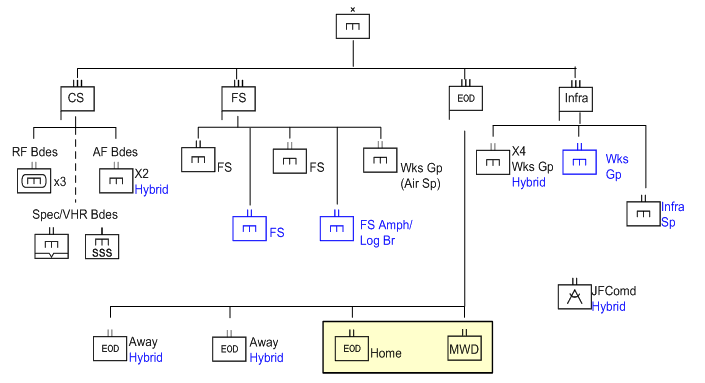The Future Structure of the United Kingdom Military Engineering Capability
Introduction. In common with our Allies, the British Army is reducing in size and restructuring; this article is intended to provide an overview of the future structure of the British Army and the Army’s military engineers (The Corps of Royal Engineers (RE)). Army engineers will continue to be responsible for providing military engineering support to all UK forces operating in the Land Environment and the capabilities assigned to the Maritime, Land and Air Components, as well as the specialist capabilities that support the force as a whole, are described below.
Lieutenant Colonel (Retd) Simon Tenison,
Staff Officer 1, Military Engineering Lessons and International,
UK Army Capability Directorate Combat Support
1. Army Structure. The Army will be organised in echelons at graduated readiness, with a mix of Reaction, Adaptable and Committed forces:
a. Reaction Forces (RF) will be optimised for combined arms manoeuvre, in a joint context, and in complex and potentially high threat or high intensity environments, notably in urban terrain. The RF is the short-notice (high readiness and very high readiness) contingent capability and conventional deterrence for defence. It will come under the command of a deployable divisional Headquarters and will generate two Very High Readiness (VHR) battlegroups: the Lead Air Assault Task Force (AATF) and the Lead Armoured Infantry Battlegroup. It will also be capable of delivering the Force Elements (FE) for the first three Roulements (18 months) of an enduring operation or, at best effort, a non-enduring operation of up to three brigades within a divisional context.
b. Adaptable Forces (AF) will be the primary source of capability for Defence Engagement at home (eg, engaging closely with civil society to sustain the Army structure [recruiting], as well as demonstrating relevance, utility and value ) and overseas (eg, capacity building) and will also provide the additional capabilities required for an enduring operation.
c. Committed Forces will be generated from the Adaptable Force to meet standing tasks in UK and abroad, such as Cyprus and the Falkland Islands.
2. Engineer Structure. The figure below shows the future structure of the Royal Engineers.

3. Engineer Brigade. The engineer brigade will consist of the four OF-5 groups, each of which is focused on providing support to specific elements of the force; about 75% of all military engineers will be in this brigade. In order to develop effective regular/reserve integration, the future structure of the Corps incorporates a mix of hybrid regiments (battalions), which include both regular and reserve sub-units, as well as pairing of regular and reserve regiments (battalions). Some key capabilities will be provided by the reserves, where this is appropriate and/or necessary. For example, some specialist skills such as the operation and maintenance of the utilities infrastructure (eg, water, power) are not required to be held at readiness to deploy on a contingent operation, cannot easily be trained/maintained by regular soldiers and can more easily/cost-effectively be provided by a reserve soldier working full time in the respective industry (and part time as a soldier).4. The Close Support Engineer Group [CS in diagram] will consist of:
a. Three regular close support engineer regiments (battalions) to support the Reactive Force.
b. Two hybrid close support engineer regiments (battalions) to support the Adaptive Force.
c. Support to the Very High Readiness Specialist Brigades:
(1) A single Air Assault Engineer Regiment (battalion) to support the Air Asslt Bde; this Regiment is affiliated to another regular regiment that includes a reserve parachute engineer squadron (company) in its organisation.
(2) A single Independent Commando Engineer Squadron (company) to support the Commando Brigade (Maritime Component); this Squadron is affiliated to a regular regiment that includes a reserve commando engineer squadron (company) in its organisation.
5. The Force Support Engineer Group [FS in diagram] will consist of:
a. A single engineer regiment (battalion) paired with a reserve regiment (battalion), with the primary role of supporting the Land Component.
b. A single engineer regiment (battalion) paired with a reserve regiment (battalion), with the primary role of supporting the Air Component.
c. A single engineer works group (not battalion size, but OF-4 command), with capability teams including design, power etc, to support the Air Component.
6. The EOD & Search Group [EOD in diagram] will consist of:
a. Two hybrid engineer EOD regiments (battalions).
b. A single regular Royal Logistic Corps EOD regiment (battalion). [In yellow shaded box on diagram; not RE]
c. A single regular military working dog regiment (battalion). [In yellow shaded box on diagram; not RE]
7. The Infrastructure Support Engineer Group [Infra in diagram] will consist of:
a. Four hybrid specialist engineer works groups (not battalion size, but OF-4 command), with capability teams including design, water development, fuel, etc.
b. A single reserve specialist engineer works group (not battalion size, but OF-4 command), with capability teams including design, power and water infrastructure, rail and port operation etc.
c. A single reserve infrastructure support engineer regiment (battalion).
8. Support to the Joint Force Intelligence Group [JF Comd in diagram – bottom right] includes a single hybrid geographic engineer regiment (battalion).